Learn how to make a sourdough starter the easy way. You will learn all about what a sourdough starter is, what you need to make one, how to make it without endless feedings and wasteful discard, and why the whole process doesn't have to be as difficult and time-consuming as you think!
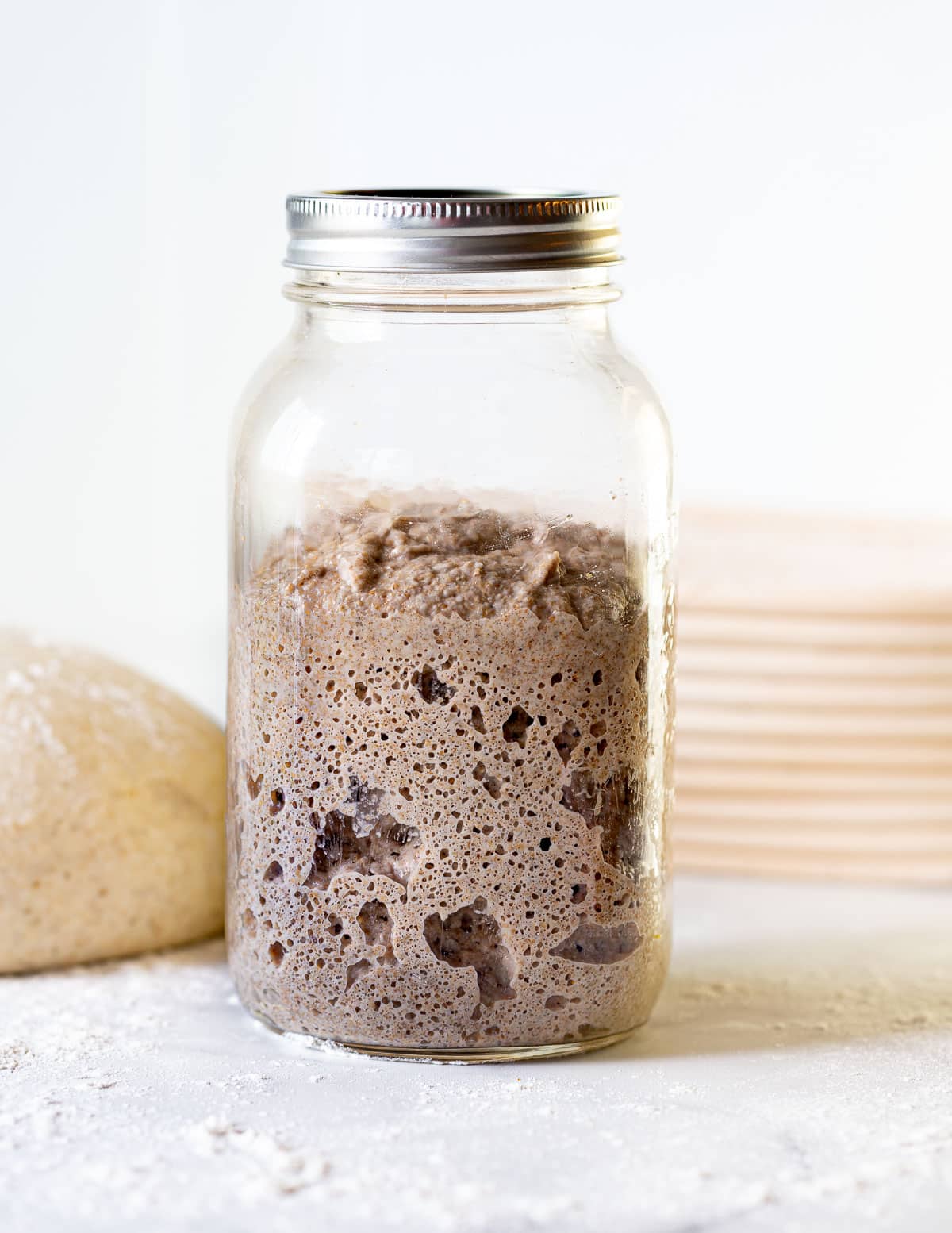
💌 SAVE THIS RECIPE!
Watch out for more tasty treats coming your way too! Unsubscribe at any time.
FEATURED COMMENT:
"All my attempts at making my own starter have failed, including a gifted starter from a famous local baker making super delicious breads and pastries. Here you come to the rescue! Just wow! Only 3 weeks into it … all my bakes have been texturally wonderful and delicious! I have to say the rye flour is the key to this superstar starter. Thank you for sharing and teaching us your knowledge and experience!!!" - Lea ⭐️⭐️⭐️⭐️⭐️ More reviews →
Question for you? Are you ready to learn how to make a sourdough starter? Or let me rephrase...
Are you ready to unlearn everything that you think you know about making sourdough starters and re-learn that it doesn't have to be as difficult as everyone in every cookbook and recipe on the internet makes out?
Yes!!! I was hoping you would say that. Because actually, a sourdough starter is pretty easy to make and look after.
Mel x
This post is long, detailed and contains lots of essential information. I recommend you read the entire thing before making a start, but when you come back to it again, feel free to jump to where you want to be via the table of contents below:
Jump to:
- What Is A Sourdough Starter?
- What Is Wild Yeast?
- What Do You Need To Make A Sourdough Starter?
- The Best Container For Sourdough Starter
- The Best Flour For Sourdough Starter
- Can I Mix Flours In My Sourdough Starter?
- Feeding Sourdough Starter
- Do You Have To Discard Sourdough Starter Every Time You Feed It?
- How Do I Know When I Can Bake Bread With It?
- How To Make A Sourdough Starter From Scratch With No Discard
- Sourdough Starter Names
- How To Keep A Sourdough Starter Warm
- Sourdough Starter Success Tips
- My Starter Is Bubbly & Consistently Rising & Falling, Now What?
- How Soon After Feeding Can I Use Sourdough Starter?
- What Do I Do If I Want To Make Something Other Than Bread With My Starter?
- How Much Sourdough Starter To Use
- How Much Sourdough Starter To Keep
- What Can I Make With Sourdough Starter?
- A Sourdough Starter Insurance Policy
- What Equipment Should I Gather In Preparation For Making My 1st Loaf Of Bread?
- Why Measure In Grams and not ounces or cups?
- Important To Bear In Mind
- Sourdough starter FAQ
- Recipe
- More Easy Bread Recipes
- Reviews & Questions
Most recipes online are just plain mind-boggling with lots of complicated steps and unfamiliar terms and math ... I mean, I hated math at school, and I sure don't want to be calculating complicated percentages when all I want to do is make a loaf of bread.
So I am here to demystify it. This is my simple, no-fuss guide to making a sourdough starter. I want to make the whole process accessible and approachable.
I want anyone, whether a natural baker or not, to be able to come along and learn to make a sourdough starter and a basic loaf of sourdough bread without getting confused over a million different complicated steps and without having to negotiate unfamiliar baker's terminology.
Of course, there is a time and a place for the proper terminology, baker's percentages and dough hydration, etc, but the average person isn't bothered with all that. They just want to come along and make an uncomplicated, easy starter, then knock out a pretty decent loaf of bread once it's ready. That's it.
So if you are that average person who just wants to learn to make a sourdough starter with no fuss and no complicated instructions, then you are in the right place.
And if you don't want to be making massive jars of starter that grow and grow, take over your entire kitchen and need feeding twice a day without fail for the rest of your life, while you try to figure out what to do with the massive amounts that you are told to discard, you have also come to the right place.
I am going to teach you what you need to know to make a happy and thriving starter, without any of the superfluous details that you don't need to know, and it's all going to be done waste-free! Yep, you heard me right. No discard.
What Is A Sourdough Starter?
A sourdough starter is a live culture which you can use to leaven (rise) baked goods by adding a small amount to the dough. It's the oldest form of leavening bread, and is thought to originate from ancient Egyptian times.
A sourdough starter is created by mixing flour and water and then allowing the mixture to sit for some time. During that time, it begins to ferment, and wild yeast, which are already present in the flour and the air around us, will start to grow and thrive as long as conditions are right.
The yeast eats the natural sugars in the flour and converts it into lactic (and other) acids, which is what gives sourdough its characteristic tang. Carbon dioxide is produced by the yeast during this process, and this is what makes the starter, and the bread you bake with it rise.
When you make bread with a sourdough starter, you do not need to use commercial yeast.
What Is Wild Yeast?
Wild yeast is all around us, in the air, in our grains/flour and on the surface of fruit, and it was used in baking long before commercial yeast became available.
Commercial yeast is reliable and fast, whereas wild yeast is slow, a little temperamental and needs looking after. Having a starter is almost like having a real, live Tamagotchi or pet to look after.
So you might be wondering why you'd even bother. Why not just use commercial yeast if it's quicker and easier?
Well, for starters (excuse the pun!), it's fermented and, for many people, is easier to digest than bread made with commercial yeast. Secondly, you know I'm all about flavour in my recipes and everything I eat. Well, sourdough bread is FULL of complex flavour and amazing texture in a way that bread made with commercial yeast can't even get close to. And lastly, making it is an art. It's challenging, fun, rewarding, and so worth the extra time and effort it takes to make!
What Do You Need To Make A Sourdough Starter?
The ingredients list is pretty basic:
- Flour
- Water
That's it.
And the equipment you need is also pretty basic:
- A jar/container to keep the starter in and a lid for it (see just below for advice on style/size).
- A digital kitchen scale. Please don't use cups to measure when making bread or starter. Baking is a science, and cup measurements are not accurate enough if you want excellent results. In my sourdough recipes, I will be asking you to weigh all of your ingredients, including the water. You can pick up a digital kitchen scale for under $20.
- A spoon or spatula that can easily reach into the bottom of the container/jar. I like these jar spatulas because they are long and thin and make stirring and scraping the jar easy.
- An elastic band to use to mark the level your starter is at after feeding. This isn't essential, but it makes it really easy to see how much your starter has grown and when it is ready to use.
The Best Container For Sourdough Starter
A wide-mouthed, clear glass jar of between 750 ml (25 oz) and 1 litre (34 oz) is perfect. Something like a mason jar, a Weck jar, or a cleaned-up store-bought peanut butter/marinara sauce jar.
It should be clear so you can see inside easily, wide so it's easy to spoon the flour into and the starter out of, and a decent size so that when the starter rises, there is no risk of it spilling over.
I started out with recycled glass jars from the pantry and have now upgraded to Weck jars. They really are perfect. Wide, smooth sides for easy stirring, and the glass lids without the rubber seals and clips are ideal for covering the starter without making it airtight.
The Best Flour For Sourdough Starter
Technically, you can use any good-quality unbleached flour to make a sourdough starter, but some flours create more demanding or vigorous starters than others.
Common flours to use when making starters are all-purpose flour, bread flour, or whole wheat flour, but for this easy starter recipe, you need to use rye flour.
Using rye flour makes the process almost foolproof. Your starter will come to life a lot quicker than starters made with other flours, and it will get more nutrients, so it will be able to cope well with the small feeds required in this recipe. Other flours will not work in this recipe.
The rye flour you use must be fresh. Don't use a bag of flour that has been sitting open in your pantry for the last 6 months. If you want your starter to be healthy and happy, you need to feed it fresh food.
We might start the process all full of enthusiasm and excitement, but there will come a time when you forget to feed your starter for a few weeks or leave it in the back of the fridge for 3 months ... Yes, I did that to my starter .... Sorry, Percy. A rye flour starter will be much more forgiving and willing to spring back to life after that than any other.
In fact, if you already have a starter made with another flour that doesn't appear to be flourishing or that you think is dead, feed it some rye flour and watch it come back to life again. They just love it!
And don't worry, just because you use rye flour to make your starter, it doesn't mean you can only make rye bread. You can use your rye starter to make white or whole-wheat bread.
Can I Mix Flours In My Sourdough Starter?
You can use a mix of different flours, like all-purpose flour mixed with rye flour or whole wheat flour, in your starter once it is established, but you might find you need to feed it more, which will mean it's harder to keep discard-free. When starting out, though, I recommend using 100% rye flour because you are going to get it up and running faster, and it will be much more resilient.
Try not to chop and change the brand of flour you use to feed your starter when you are getting it established. Be consistent and use the same for every feeding if at all possible. It will make things a lot more predictable and progress easier to track.
Once you are up and running, you can use a bit of your established starter to start new and different starters. If you have a rye starter, use a little bit of it to "seed" a new whole wheat or white flour starter. You'll have a new and happy, thriving starter almost immediately, although bear in mind that using different flours will change the feeding requirements and could mean you have to discard.
Feeding Sourdough Starter
When you make a starter, you are cultivating wild yeast. To keep it happy and make it thrive, you have to feed the wild yeast living in your starter.
Feeding is as simple as adding more flour and water. You open the jar, put it on a scale, add equal parts flour and water, stir it all up, pop the lid back on loosely and put the container back wherever you keep it.
Then, within a few hours, the wild yeast will have a party, go crazy, and your starter will begin to bubble and rise to about double its size. When the wild yeast has consumed all of the natural sugars in the flour, they will calm down, go to sleep, and the starter will slowly fall back down as carbon dioxide stops being produced.
Do You Have To Discard Sourdough Starter Every Time You Feed It?
Most recipes will have you feeding your starter every day. Sometimes twice a day. They will also have you discard half of it each time. This is so wasteful and unnecessary.
With my recipe, you do not have to discard the sourdough starter every time you feed it. Instead, you feed the starter every day with equal amounts of flour and water without discarding any while you are getting it established, then once it is established (after a week or two) you only need to feed it the day before you want to make bread.
Then you will use all but a teeny tiny amount of the starter in your baking and leave the rest (which amounts to just the scrapings in the jar ) in your fridge until the next time you bake. When that time comes around, you will feed the starter the day before you need it, using only as much flour and water as you need to make the amount of starter required by your recipe.
There really is no good reason to keep masses and masses of starter bubbling away, and there's even less of a good reason to be wasting flour every day when you don't need to.
How Do I Know When I Can Bake Bread With It?
Once your newborn starter looks really bubbly, like the inside of an Aero bar or chocolate mousse, and doubles after you feed it, it is ready to start baking with, and it will continue to get stronger as it gets more mature.
The optimum time to prepare bread dough with your starter is when the starter has reached its peak after feeding. You will get to know what this looks like once your starter is established and you have seen it rise and fall.
Then, when you mix the starter with the fresh flour, water and salt needed to make your loaf, it is provided with more food. It eats the natural sugars in the flour, and carbon dioxide is produced, which causes the dough/bread to rise.
How To Make A Sourdough Starter From Scratch With No Discard
(For detailed measurements and instructions, see the printable recipe card).
It is really easy to cultivate your own sourdough starter. There are lots of different recipes out there, but they tend to be complicated and very wasteful. My recipe is as simple as it gets. Flour, water, and time. That's it. And you won't have any excess starter to discard!
Here's how:
Day 1 - Get a clean jar. Add to it 25 grams of flour and 25 grams of room-temperature water. Mix well so you can't see any dry flour, level it as best you can and cover loosely with a lid. Don't screw the lid on tightly. If you have an elastic band, put it over the jar, and level with the top of the starter (to measure progress). Leave the jar in a sheltered, draft-free spot for about 24 hours. It doesn't have to be exact. An hour less or a few hours more is fine. If your room is cooler than 20°C (68°F), you will speed things up greatly if you can increase the temperature a bit. See my tips under the heading "How to keep a sourdough starter warm" below for how to keep your starter nice and cozy.
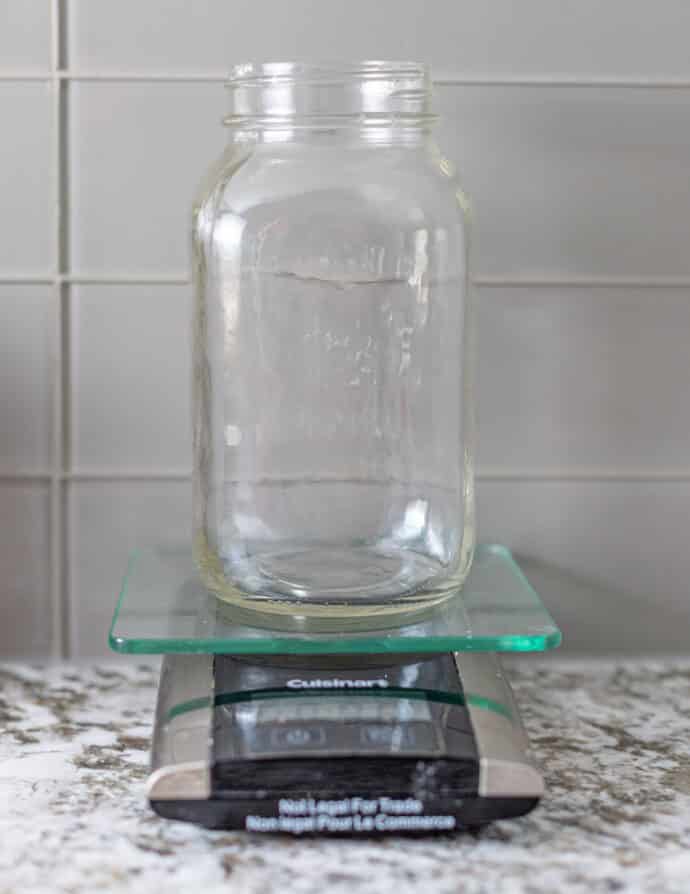
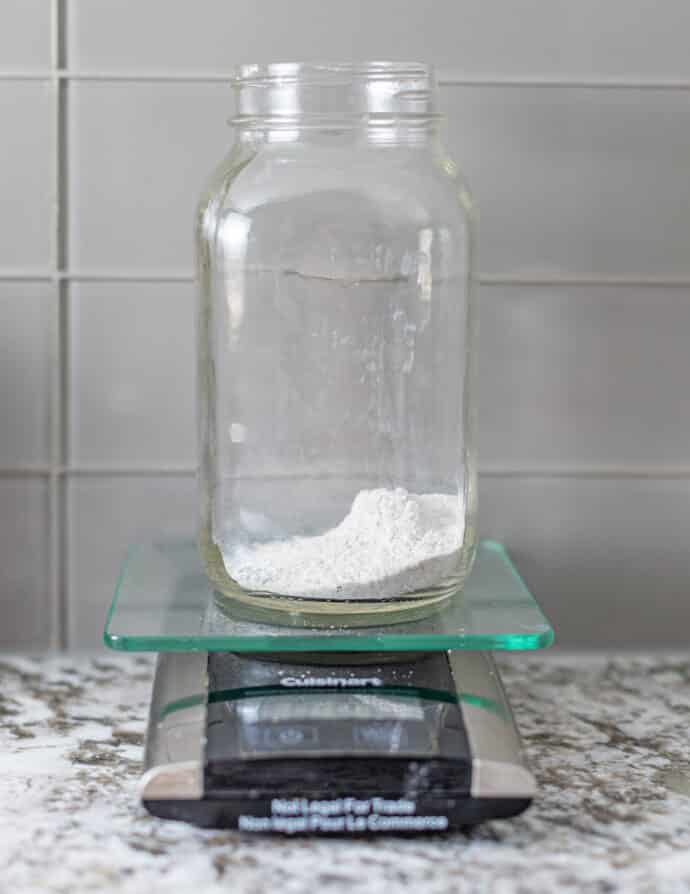
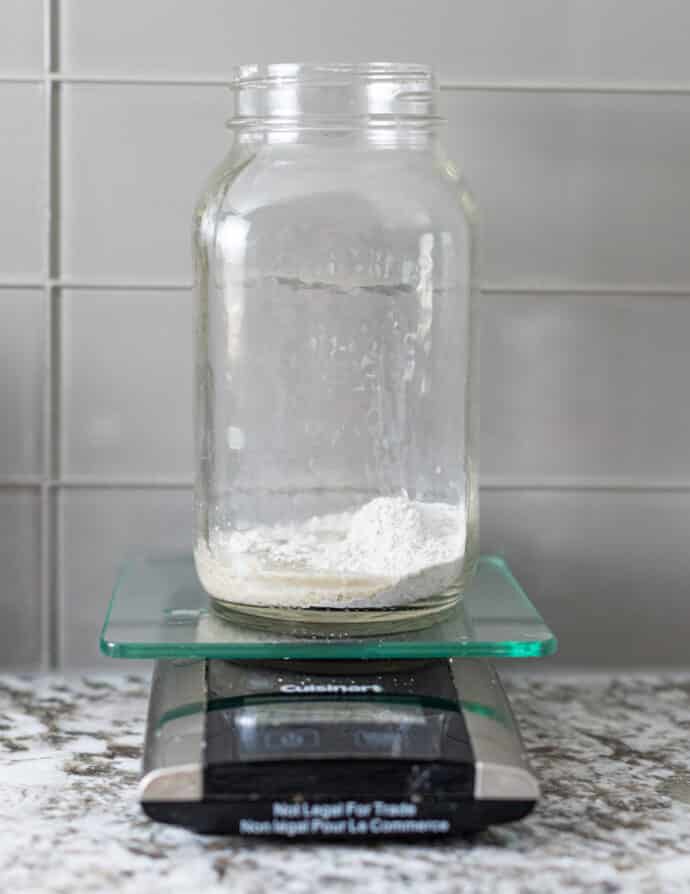
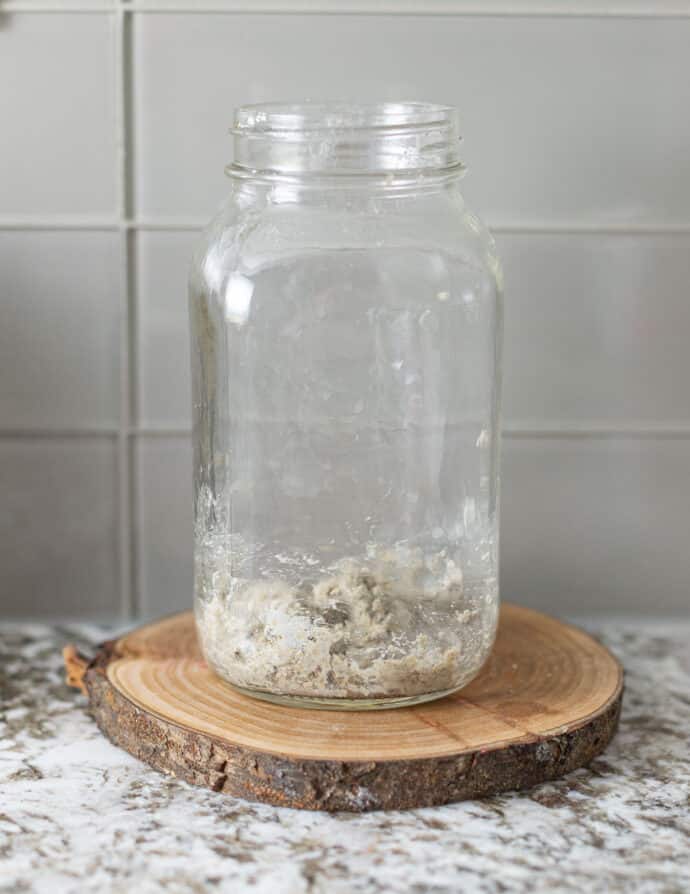
Day 2 - It probably won't look any different today but may smell a little milky or fruity. It might have a bubble or two or it might not. Uncover the jar and add another 25 grams of flour and 25 grams of water. Stir, level again as best you can and leave loosely covered again for about 24 hours.
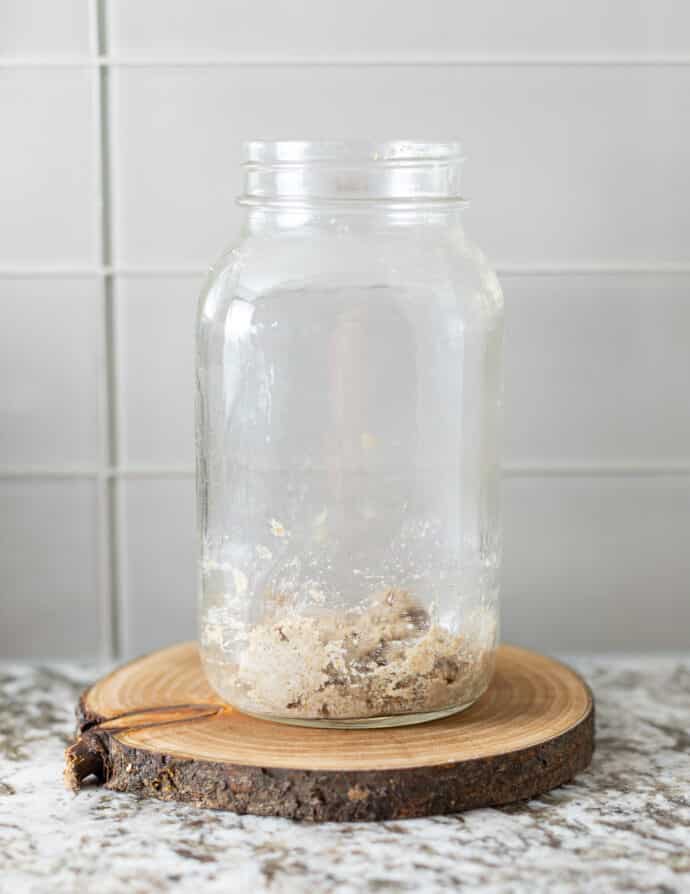
Days 3 to 7 - Repeat this process daily for the next 5 days. DO NOT discard any of the starter.
After day 2 or 3 - You will probably start to see a few bubbles forming and notice a slightly milky or fruity smell when you sniff it. You could also get a sudden burst of bubbly/rising activity. This sometimes fools people into thinking it's ready, then the activity suddenly stops again and they are left thinking their starter died. Just keep going if this happens. It's common (but doesn't happen to everyone) and is due to different bacteria in the flour which will die off as the starter ferments and the PH changes. It will all go quiet then the good guys will take over and things will start happening for real. Progress is different for everyone though so don't worry if nothing appears to be happening. Just keep going with the daily feedings.
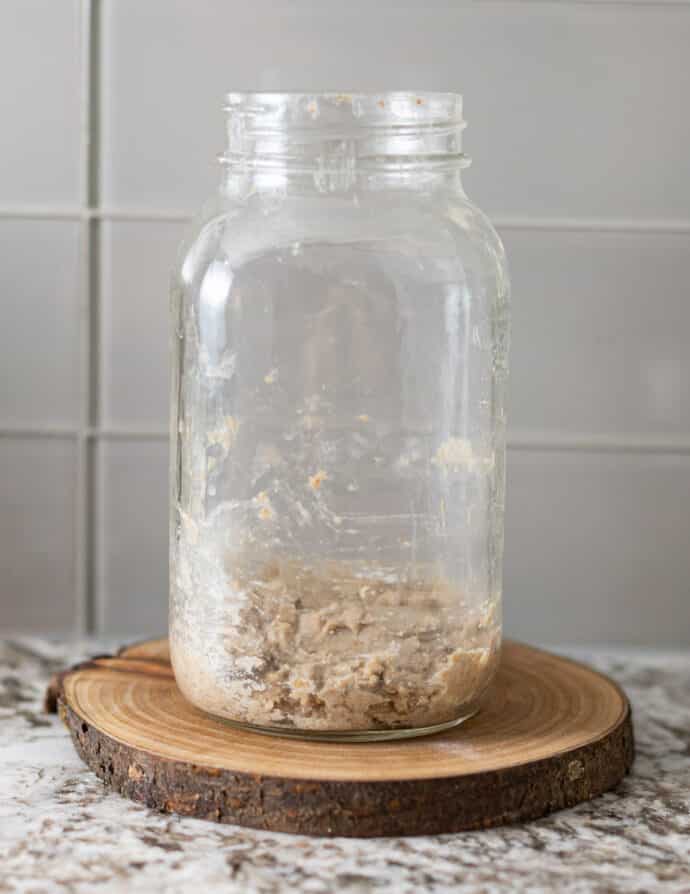
From days 4 to 6 changes to the appearance and smell should be very noticeable. You should be seeing bubbles and it should be rising a little between feedings. Again though, don't worry if yours is a little slow. Just carry on regardless, feeding it every day with 25 grams of flour and 25 grams of water.
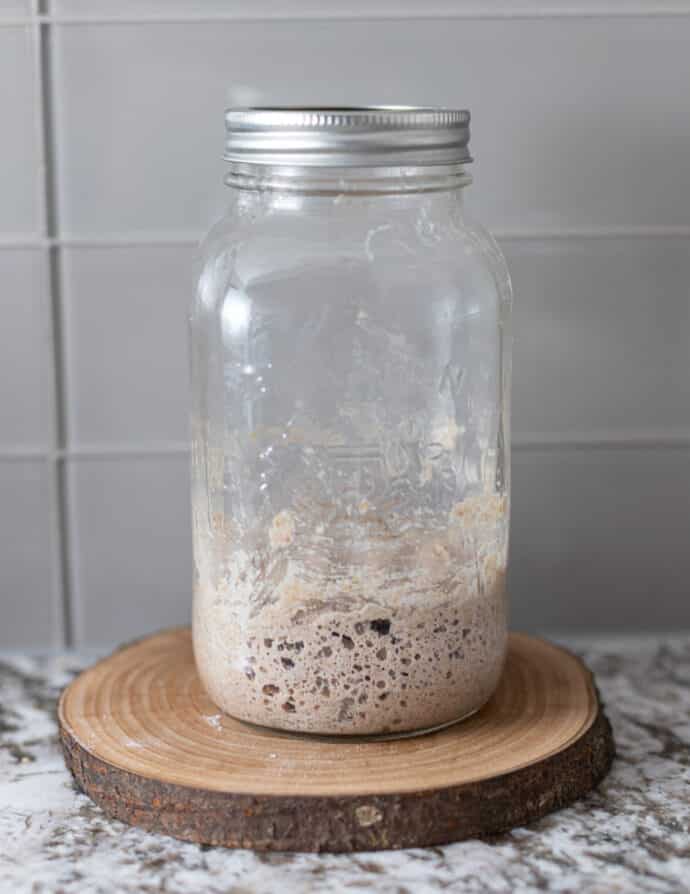
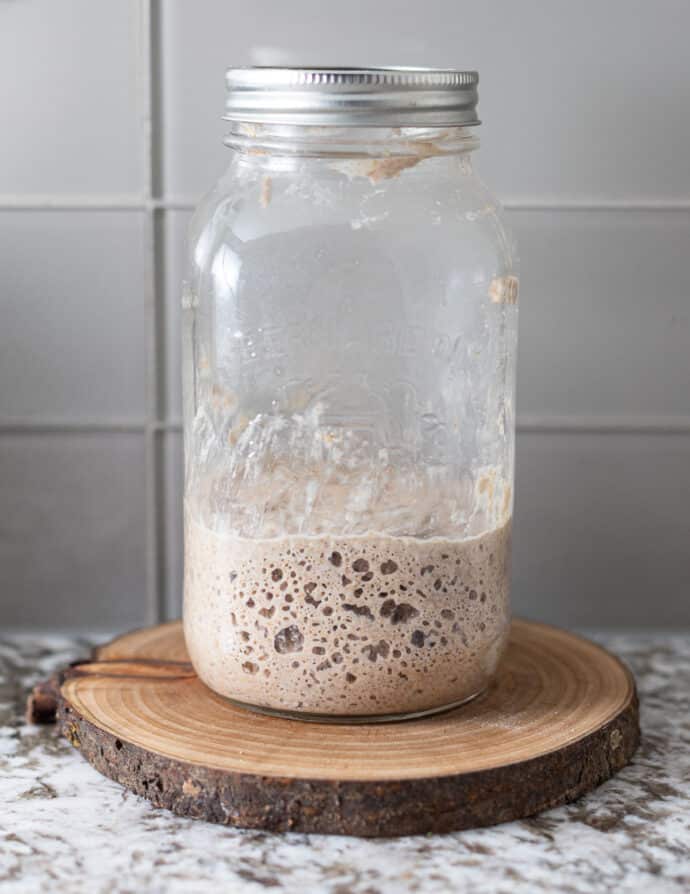
From days 7 to 8 your starter should be getting really bubbly after feeding and it should be starting to rise and then fall reliably and predictably after each feed. Again though don't worry if yours isn't. This process can be unpredictable. Just keep going but try to keep it somewhere a little warmer as that will help. See my tips under the heading "How to keep a sourdough starter warm" below for how to keep your starter nice and cozy.
Here is mine on Day 7:
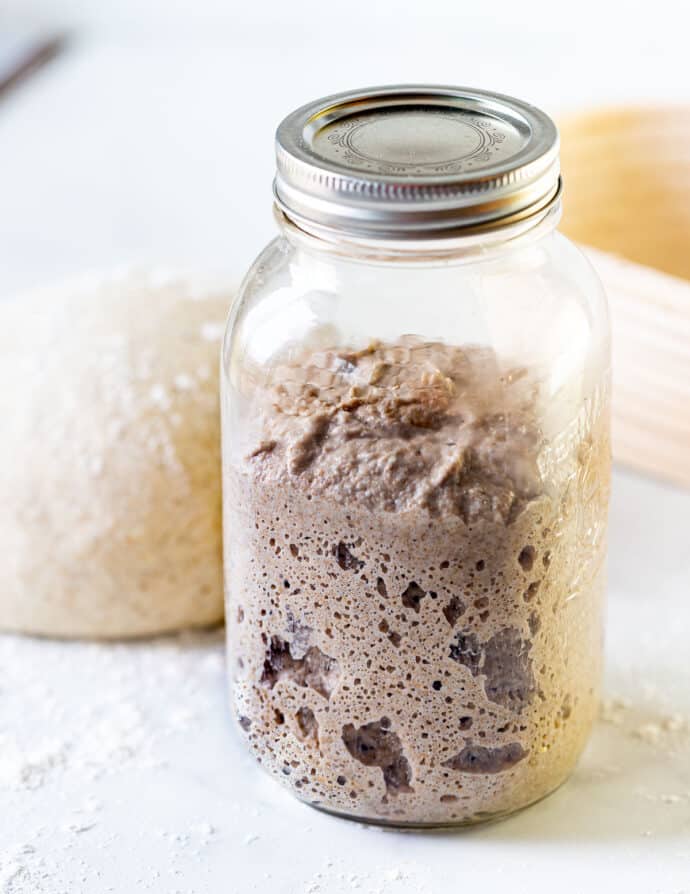
Once your sourdough starter is reliably doubling in size after feeding and looks really spongy, fluffy and bubbly like mine in the picture above, it is ready to make bread with.
Well done! You made a sourdough starter!
Sourdough Starter Names
Now that you have your own living and breathing sourdough starter, you need to hold a naming ceremony and make it part of the family. It's an essential right of passage into the sourdough bread baking world ;O)
Here are some fun sourdough starter names for inspiration:
- Doughreen
- Bread Pitt
- Jane Dough
- Gloopy
- Little Bread Rising Hood
- Clint Yeastwood
- Bubbles
- Frankendough
I currently have two. Percy and Michael Bubbly!
Here is Percy, my old sourdough starter. I think he's about 20 years old. He was born and bred in England, then got rudely dehydrated on a piece of paper and flown to Canada, where he started a new life. Charlie (the dog) loves the smell of him and is there by my side for every feeding and bake session!
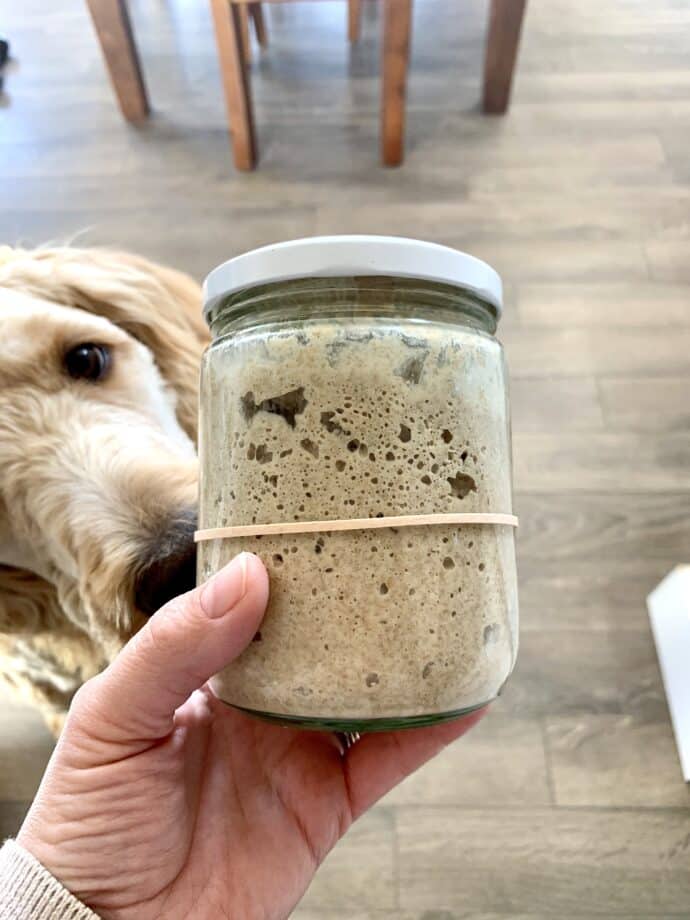
How To Keep A Sourdough Starter Warm
To get things moving along quickly, a temperature between 20°C (72°F) to 26 °C (80°F) is perfect. Some of us are lucky and have an environment naturally at that temperature, but if the room you keep your starter in is cooler then things will move along quite slowly. To be clear, it will still happen if it's cooler, it will just take much longer.
Here are some ideas to provide your starter with a warmer environment to help speed it up:
- Move it to another room - You might have one room in your house that gets warmer than others. Try leaving it in there.
- Use the light in your oven - Simply place the jar of starter in a cold oven and turn the light on. The heat from the bulb will keep your starter warm. Just make sure no one comes along and turns the oven on while it's in there!
- Use your home heating - Place the jar of starter near (but not too near) the furnace, radiator, fireplace, or stove.
- Use an Instant Pot - If your Instant Pot has a yogurt setting, set it to low and place the jar of starter on the trivet inside. It's important to leave the lid off the Instant Pot as otherwise it will get too hot for your starter.
- On top of your fridge/fridge freezer - This is usually a nice warm spot and works well if you don't have built-in appliances.
- A sunny windowsill - Don't put it in direct contact with the sun, as it could damage your starter, but put it in indirect sunlight or in a dark box on the windowsill to protect it.
- In the airing cupboard - If you are in the UK in an older-style house, you might well have one of these.
- A warm closet - I have forced air heating in my house, and the closets have vents in them and get really warm. My starter loves it in there!
Sourdough Starter Success Tips
- Read this entire post before you begin. Everything here is useful and will set you up for success.
- Always weigh your ingredients. That means the flour and the water. When baking (which is what you will ultimately do with this starter), it is really important to be precise and cups are not precise enough. You can pick up a digital kitchen scale for under $15.
- Use rye flour for the easiest and hardiest starter.
- Do not use old flour. You wouldn't feed a baby old milk. Your starter needs fresh food that's full of nutrients, just like a baby does. If you use old flour, your starter will likely be harder to get goin,g and there's a strong chance it will end up getting mouldy.
- Do not use bleached flour.
- Don't be tempted to deviate from the recipe.
- Don't rush it. It takes as long as it takes, and patience is important.
- Don't store your starter in a metal container.
- Once established, only make as much starter as you need for your recipe and keep the scrapings in the jar for next time. If you accidentally end up with too much, use it up in a recipe that calls for sourdough starter discard.
- Read through my FAQ if you run into any problems. I've tried to think of all the possible situations you could run into along the way and provide an answer. However, if you get stuck, feel free to reach out, and I will do my best to help.
My Starter Is Bubbly & Consistently Rising & Falling, Now What?
You have a happy and thriving sourdough starter, and you are ready to make bread.
Let's say your starter took 7 days to establish. That means that you now have 350g of sourdough starter in your jar.
25g of rye flour + 25g of water = 50 g
50 g x 7 days = 350g
.... I promise that's the extent of the math involved.
You can now remove all of that starter from the jar and use it for baking bread, or any other recipe that uses starter. You just need to leave the scrapings behind (the clingy bits that are left on the bottom and sides). These clingy bits are all you need to keep your starter going.
Put the (almost) empty jar with clingy bits in the fridge and leave it there until a day or two before you want to make bread again.
Here is my jar of sourdough starter scrapings:
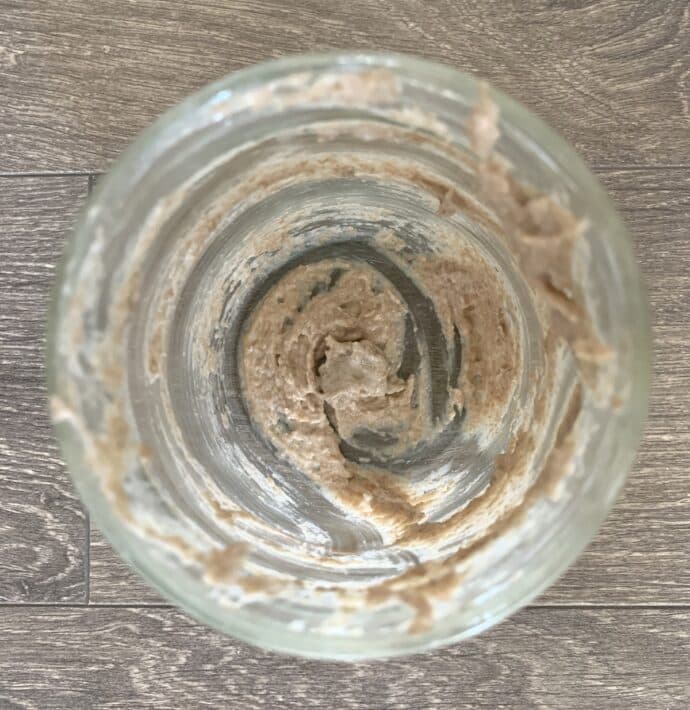
Then next time you want to bake:
- If a week or less has passed since you put the jar in the fridge - the night before you want to bake, read your recipe and see how much starter it calls for.
If it says you need 100 g of starter, put 50g of flour and 50g of water into your starter jar and stir it up really well. 50 g + 50 g = 100 g, which is what you need for the recipe.
If the recipe says you need 300g of starter, put 150g of flour and 150g of water in your jar. 150g + 150g = 300g.
Get it? Then cover the jar and leave it wherever you keep it, until the next morning, when it should be at its peak and ready to bake with. Take out all of the starter to use in your recipe, leaving the scrapings in the jar and pop it back into the fridge for next time, then follow these directions again the next time you want to bake. - If 2 weeks have passed since you put the jar in the fridge - 2 nights before you want to bake, read your recipe and see how much starter it calls for. You are going to feed the starter over 2 nights to get it excited again.
If your recipe says you need 100 g of starter, put 25g of flour and 25g of water into your starter jar and stir it up really well. Then, the following night, add another 25g of flour and 25g of water. That brings you up to 100g of starter. Leave it until the next morning, and it should be nice and bubbly, and ready to bake with.
If the recipe says you need 300g of starter, put 75g of flour and 75g of water in your jar and stir it up, then the following night add another 75g of flour and 75g of water, stir it up and leave it 'til morning when it should be ready to bake with. - If more than 2 weeks have passed since you put the jar in the fridge - Don't worry. If it's only a few days over 2 weeks, follow my directions above, and you should be fine. If it's much longer, then you might need to feed it over 3 or 4 nights to get it raring to go again. The good news is that it's pretty hard to kill it so no matter how long you've left it, it should be salvageable (unless it's mouldy - see my FAQ below for more info on that).
Don't let the amount of starter you have build up in the jar. Too much and it can get sluggish and struggle to double in size. Just feed it as much flour and water as you need for your bake and no more. If you accidentally end up with too much, use it up by making any recipe that calls for sourdough discard.
How Soon After Feeding Can I Use Sourdough Starter?
After feeding your starter, you need to wait for it to reach its peak before you can bake with it. This time varies from starter to starter and is also dependent on temperature. For me it's about 6 to 8 hours. If it's particularly warm where you are, it could happen more quickly. You will get to know how long yours takes once you've been feeding it for a while.
I feed my starter the evening before I plan to bake with it because I tend to mix my dough in the morning. If you are going to mix your dough in the evening, feed your starter when you wake up in the morning.
What Do I Do If I Want To Make Something Other Than Bread With My Starter?
By making a waste-free sourdough starter, you lose the problem of having to figure out what to do with all of the discard. But sometimes having some extra starter available to make pancakes, crumpets, or waffles is a good thing.
If you want some extra starter available to do this, feed your starter as normal the night before you are baking, but use some extra flour and water so you have more than just the scrapings left in the jar after making the bread. Then you can use it right away or leave it in the fridge until you need it.
If you aren't making bread but want to make something else that calls for discard, simply feed your starter enough to make the amount of discard called for in the recipe a day or two before you want to make it. Take out what you need for your recipe and pop the scrapings back in the fridge for next time.
How Much Sourdough Starter To Use
You might be wondering what the ratio of sourdough starter to flour is when you make bread.
The amount of starter you need to use will be listed in the recipe you are following. It varies from recipe to recipe, but the general rule of thumb is that you use about 1/5th of the amount of flour. So for every 500g of flour, that's about 100g of starter.
The more starter you use, the quicker the progress will be and the less sour your bread will be. If you use less starter, things will take much longer to happen, but you will get more complex flavours and more sourness.
I suggest following recipes as they are written to start with, until you get the hang of things, then you can experiment with amounts to get the balance of sourness and time that you need once you are more experienced.
I don't like my sourdough bread to be too sour, so I never use less than 100g of starter to 500g of flour. That's a perfect balance for me.
How Much Sourdough Starter To Keep
When you use your sourdough starter for baking, all you need to save are the scrapings that are left in the jar. You will feed the scrapings in the jar with more flour and water the night before you want to bake again, and in the meantime, the jar will stay in the fridge. There is no need to keep more starter than that.
What Can I Make With Sourdough Starter?
You aren't just limited to bread when using sourdough starter. Here are some other ideas for using it:
- pancakes or crepes
- waffles
- crumpets
- cake
- muffins
- banana bread
- pizza
- American-style biscuits
- crackers
- pretzels
- bagels
- dog treats
- cookies
- cinnamon rolls
A Sourdough Starter Insurance Policy
Just in case the very worst happens and your starter gets mouldy or dies or put in the dishwasher accidentally (yes, that happened to me once!), you could stash a little bit away as insurance. Keep a tiny bit in a pot or bag in the freezer and change it every 3 or 4 months for a fresh piece, or scrape some wet starter in a thin layer onto some parchment paper and allow it to dry out completely until hard and moisture-free. Then scrape it off and keep it in an airtight jar in the back of the pantry. It will keep just about forever like that.
Hopefully, you'll never need it, but if you do, it will be there ready and waiting to help you get up snd running again quickly.
What Equipment Should I Gather In Preparation For Making My 1st Loaf Of Bread?
While your starter comes to life over the next week or two, you might want to prepare for when you make your first sourdough bread recipe.
For that, you will need:
- a large mixing bowl for mixing the dough
- a Dutch oven or a baking/pizza stone, but a baking tray will do if that's all you have
- a metal roasting pan or baking tray with sides and some boiling water (if you aren't using a Dutch oven)
- rice flour, coarse cornmeal or polenta - This isn't for actually making the bread. It's to ensure your dough doesn't stick to anything. Regular flour does not work well because it just absorbs the moisture from the dough and then sticks. If you've got rice (white or brown) in your pantry, and you have a blender, you can make your own rice flour in 2 minutes. Just pour the rice into the blender and blend until a fine powder. Store in an airtight container.
- a banneton (proofing basket) or a mixing bowl lined with a clean dish towel
- a very sharp serrated knife or a razor blade (or a lame/grignette if you want to get all posh) for scoring the bread.
- a spray bottle filled with water
Amazon sell handy little sourdough starter kits that contain a banneton (proofing basket), a lame and a dough scraper. I bought myself one when I was starting out. The rest of the things you probably have at home anyway.
Why Measure In Grams and not ounces or cups?
(This section has been added post-publication after getting lots of messages about why I recommend measuring in grams and not ounces or cups)
The amounts of flour and water that you use MUST be absolutely exact and the only way to make them exact is to weigh them. Ounces don't go small enough. Grams are the only accurate way to measure very small amounts.
We need to use really small amounts of flour in this recipe so that we don't have to discard anything. If we were using larger amounts that you could potentially measure in ounces it would all build up too quickly in the jar and then we'd have to discard which is something this recipe avoids so that we aren't wasting precious food. That's what makes this recipe different to every other one out there. With every other recipe I have seen, you litreally have to throw away half of your starter every single day. That is something I cannot get behind when it is completely unnecessary.
I absolutely do not recommend the use of cups to measure because they aren't accurate enough for measuring a recipe like this. The measurements need to be absolutely exact so that you end up with a 100% hydration starter (50% water 50% flour). If the amounts of water or flour are even slightly off then the hydration won't be correct and then you will run into all sorts of problems when you come to make a sourdough bread recipe with the starter because they all rely on you having a 100% hydration starter. If it's not you'll end up with your dough being either too dry or way too wet and you won't get a good result.
Sourdough is a science. If it's going to work well you have to weigh. All digital kitchen scales measure in grams and you can pick one up for less than $15. Even the big grocery stores sell them (like Walmart etc). The amount you spend on a scale will be offset very quickly by the amount of flour that you don't have to buy and then throw away every day like you would have to do with any other recipe.
A scale is such a good investment because all of your baking recipes will turn out better if you weigh the ingredients. It might seem like a cup is a cup, but 1 cup of every single type/brand of flour weighs a different amount, and even the way you fill a cup changes how much flour ends up in it. Scooping flour results in about 25% more than spooning it in gently and levelling it with a knife. Because of that, you can never be absolutely accurate when using them and that's why I always bang on about using a scale in my baking recipes and why professional bakers don't use cups to measure. They all weigh because it's the only way to be accurate and consistent.
I have added cup/tablespoon/teaspoon measurements in this recipe (under duress ;O) for those people without a scale, but if you want a good result (in this and more importantly your future bread) then you must use a scale.
Sourdough bread is not easy to make at the best of times until you've got some experience behind you. If you don't have all of the measurements correct you'll just be making the whole process even more difficult for yourself and will likely end up failing.
And that's why I recommend measuring in grams!
Important To Bear In Mind
When your starter is just a few weeks old, it isn't yet fully mature. Although it can bake bread, it won't have the power and strength of a mature starter. It will be quite weak and slow.
It's also important to realize that if you are new to the world of baking sourdough, your technique won't be perfect. That comes with time too.
Sourdough is as much an art as it is a science. For the first little while your bread might not be 100% perfect. Keep using your starter and practicing your technique, and you and your starter will get better and better.
Remember too that no two sourdough starters are the same and everyone's will behave differently. You will get used to your starter's unique characteristics once it's been in the family for a while.
Sourdough starter FAQ
No. Cover it with the lid loosely but don't do it up tightly. We want to cover it to stop anything accidentally falling (or crawling) into the jar, but we don't want to seal it. This is because as the carbon dioxide builds up in the jar, it will create pressure. If you screw the lid on tightly, you could end up with a mini sourdough explosion, which I can tell you from experience is not pretty!
Yes, for most people, tap water is fine to use when making a sourdough starter. If it's heavily chlorinated, though, you might find that filtered water works better. If your tap water is treated with chloramine, some filters, such as Brita, don't filter them out effectively. In that case, you will need to use store-bought spring water. I recommend trying with your tap water, then if you have no luck after 7 to 10 days, switch to filtered or spring water for the second attempt.
Did you use rye as recommended? If so, then this is more than likely temperature-related. Is your house or the room your starter in quite cool (below 20 °C (68 °F) ? Cooler temperatures really slow things down, so although something probably is happening, it's happening so slowly that you can't notice it yet. Try moving the jar somewhere warmer. A warmer room, maybe on top of the fridge, or even in the oven with just the light on.
If the temperature is in range and your rye flour is fresh, then there is a chance your tap water is to blame. Try using filtered or spring water instead.
This liquid is commonly known as "hooch". It basically means that your starter is hungry or lacking nutrients, and you often see it if you miss a feeding or are late to feed. You can pour it off or stir it in. You are more likely to see this if you use white flour because it doesn't contain as many nutrients. That's why I recommend rye flour.
This means your starter is hungry. The strong smell will go away when you feed it.
It's always wise to never have your jar more than half full of unfed starter because it needs room to grow after feeding, and you don't want it to overflow. In most instances with this recipe, and as long as you used a 1 litre or larger jar, this shouldn't happen, but in the rare event it does, simply remove most of the starter from the jar, just leaving a little bit at the bottom (even as little as a teaspoon is fine) and start feeding that small portion. Or transfer a small bit to a new, clean jar and start feeding it there. The excess starter that you removed can be composted, added to the dough of a regular yeasted loaf, pizza dough or used to make pancakes or waffles.
When your starter is fluffy and bubbly and is reliably and consistently rising to about double its height and then falling back after each feed, it is ready to make bread. For most, this will be around the 7 or 8 day mark. Again, though, it is different for everyone. Don't worry if yours takes longer.
No, just because you use rye flour to make your starter, it doesn't mean you can only make rye bread. You can use your rye starter to make any sourdough bread, including white or whole wheat.
This is common with new starters until they mature. Try taking it out of the fridge two days before you bake. Read your recipe and see how much starter it calls for.
If it says you need 100 g of starter, put 25g of flour and 25g of water into your starter jar and stir it up really well. Then, the following night, add another 25g of flour and 25g of water. That brings you up to 100g of starter. Leave it until the next morning, and it should be nice and bubbly and ready to bake with.
If the recipe says you need 300g of starter, put 75g of flour and 75g of water in your jar and stir it up, then the following night add another 75g of flour and 75g of water, stir it up and leave it 'til morning, when it should be ready to bake with and more vigorous. Also, check the temperature of the area where you are leaving your bread to rise. If it's too cool things will take a very long time. Move it somewhere over 21°C (70°F) and you will hopefully see a difference.
This is more than likely temperature/season-related. Keep it somewhere warmer, and things will speed up a bit.
If this happens, then you will need to feed it again and wait for it to reach its peak before you can bake.
Some people never clean the jar. I like to give my starter a new, clean jar about once every couple of weeks. Have the new jar ready when you are about to feed your starter. Scrape the starter out of the old jar and put it into the new jar. Feed as per usual and wash up the old jar.
A healthy starter should smell fruity, yeasty and sour in a pleasant way. If it is hungry, it will smell like alcohol or nail polish remover. If it smells cheesy or foul, then I would recommend composting it and starting afresh.
If this happens a few days after making your first starter, then just keep going with your feeding schedule. It's normal to get a burst of sudden activity and for it to calm down for a while before things really take off.
If this happens to an established starter, though, dispose of all but a really small amount ( just keep a teaspoon or two of it) and start daily feeding with rye flour as per my instructions for making a new starter. It should soon perk up!
You can make your bread less sour by using more starter in your recipe. This might sound counterintuitive, but by using mor,e you are going to make things happen a lot faster. This cuts down the time the flavour has to develop and will make your bread less sour.
Use less starter to make your bread sourer. This might sound counterintuitive, but by using less starter, you will slow things down and give more time for flavour to develop. Try cutting it down by 10% and see what a difference that makes. Decrease it a little more next time if that isn't enough.
Often, if a starter is weak, it's because there is too much of it. Discard all but a tablespoon and begin feeding it daily. You should see a difference quite quickly.
You might have heard that a sourdough starter should pass a float test before you use it. This isn't an accurate enough way to check, though, so I don't recommend you do it. Some starters will float even if they are not ready to bake with, and some will sink when they are ok to bake with. All you need to know is that it is rising to twice its height after feeding and is really bubbly. As long as that happens consistently, then it's ready to bake with and there is no need to perform a float test.
Mould is not good and is often caused by using old flour. Your flour should be fresh to make a starter. The bacteria need the nutrients. You wouldn't feed a baby old milk.
Or it could be that something that shouldn't have been introduced to the jar got in there at some point. Maybe a bit of dirt on a spatula or in the jar. It can also become mouldy if it's left for ages and ages in the fridge without being used. If this happens, there's only one place for your starter to go. That's in the compost bin. R.I.P. I guess you'll be starting all over again. Take note of the tips about having a sourdough starter insurance policy a few paragraphs below.
We've all been there, and yes, it's frustrating. In my recip,e I recommend using room temperature water when feeding your starter. But if you forget to feed it the night before, get up early on your baking day and feed your starter with warm water (not hot) (we're talking about 29 °C (85°F). That should speed things up and hopefully enable you to bake the same day.
If you are reading this after making a starter with another recipe, you can easily switch to this method. Just use up your starter in your baking, saving the scrapings, keep them in the fridge until the night before you are due to bake again, and then follow my instructions for how to feed it up with rye flour the night before you need it.
Phew! I think that's it. This is officially my longest post ever, but I thought it was important to add as much information as I possibly can so that you have the best possible chance of success. I hope it enables you to feel confident in starting out and helps you foresee and tackle with ease any challenges that you may or may not face along the way.
Let me know in the comments: Have you made sourdough before? If not, are you ready to take a chance on my easy, waste-free and fuss-free method for making sourdough? If you have already started the process, how are you getting on? Any questions? Ask away in the comments and I'll get back to you as soon as I can!
Recipe
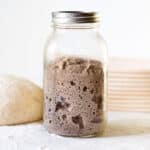
Sourdough Starter Recipe
Author:WATCH HOW TO MAKE IT
Ingredients
- about 175 grams (1¾ cup) rye flour * (plus more as necessary) - please measure in grams if at all possible - see under heading "Why measure in grams and not ounces or cups?" in post above for more info.
- 175 grams (½ cup + 3 tablespoons + 2 teaspoons) room temperature water , (plus more as necessary) (please measure in grams if at all possible).
RECOMMENDED EQUIPMENT
INSTRUCTIONS
- Please start by reading my post above. It's long, but it includes lots of important and useful information that will help you succeed.
- IMPORTANT - I do not recommend using cups/tablespoons to make this starter because they are not accurate enough.
- ALSO IMPORTANT - At no point in this process should you discard any of the starter.
- Day 1 - To a clean jar/container that's between 750 ml (25 oz) and 1 litre (34 oz) in size, add 25 grams (3 tablespoons + 2¾ teaspoons) of rye flour and 25 grams (1 tablespoon + 2 teaspoons) of room temperature water. Mix well so you can't see any dry flour, level it as best you can and cover with the jar lid. Screw it on loosely but don't fully tighten it up. Don't screw the lid on tightly. If you have an elastic band, put it over the jar so it is level with the top of the flour/water mixture. That way you can see easily if there is any increase in volume. Leave the jar in a sheltered spot for about 24 hours, ideally at a temperature of between 20°C (72°F) to 26 °C (80°F) If your kitchen is very cool see my tips in the post above for how to keep your starter warm.
- Day 2 - There probably won't be any changes yet but you might see a few bubbles and/or notice a milky smell. Open the jar of starter and add another 25 grams (3 tablespoons + 2¾ teaspoons) of rye flour and 25 grams (1 tablespoon + 2 teaspoons) water. Mix well so you can't see any dry flour, level it as best you can and cover loosely with a lid, adjust the elastic band so it's level with the top of the mixture and put the jar back in it's spot.
- Day 3 - You might see and smell some changes now. Maybe a few bubbles and a fruity smell. Open the jar of starter and add another 25 grams (3 tablespoons + 2¾ teaspoons) of rye flour and 25 grams (1 tablespoon + 2 teaspoons) water. Mix well so you can't see any dry flour, level it as best you can and cover loosely with a lid, adjust the elastic band so it's level with the top of the mixture and put the jar back in it's spot.
- Day 4 - You will likely see more bubbles today and it could be increasing in volume. Don't get excited and think it's ready to use yet though. Sometimes this happens, then the activity will stop again for a few days, so keep going for now. Open the jar of starter and add another 25 grams (3 tablespoons + 2¾ teaspoons) of rye flour and 25 grams (1 tablespoon + 2 teaspoons) water. Mix well so you can't see any dry flour, level it as best you can and cover loosely with a lid, adjust the elastic band so it's level with the top of the mixture and put the jar back in it's spot.
- Days 5 to 7 - Keep feeding it 25 grams (3 tablespoons + 2¾ teaspoons) of rye flour and 25 grams (1 tablespoon + 2 teaspoons) on days 5, 6 and 7. It should be pretty active and smell pleasantly sour and fruity by now. If by day 7 it has been rising to twice its volume then falling again after each feeding for a few days in a row then it is ready to use for baking bread. If it hasn't been rising to twice its volume consistently after feeding, just keep feeding it 25 grams (3 tablespoons + 2¾ teaspoons) of rye flour and 25 grams (1 tablespoon + 2 teaspoons) daily until it does. Ensure the area it is kept is between 20°C (72°F) to 26 °C (80°F) and no less to give it a boost. See the recipe notes for what to do if your jar starts to become more than half way full after feeding.
- Once your starter has been rising and falling consistently after feeding for a few days it is ready to bake with. Now you must name it and make it part of your family ;O)
- You can use the starter to bake bread when it is at its peak (doubled in size) after feeding. Use what is in the jar for baking with and just leave behind a tiny bit of starter. A few teaspoons is sufficient, or what amounts to the scrapings in the jar. Pop the jar of scrapings in the fridge where it can stay until the day before you bake again. It does not need to be fed in between. The next time you want to bake, remove it from the fridge the evening before and feed it so it's ready and at its peak for you the next day.
NOTES
If it says you need 100 g of starter, put 50g (½ cup) of rye flour and 50g (3 tablespoons + 1 teaspoon) of water into your starter jar and stir it up really well. 50 g + 50 g = 100 g which is what you need for the recipe.
If the recipe says you need 300g of starter, put 150g (1½ cup)of rye flour and 150g (½ cup + 2 tablespoons) of water in your jar. 150g + 150g = 300g.
Get it? Then cover the jar and leave it wherever you keep it, until the next morning when it should be at its peak and ready to bake with. Take out all of the starter to use in your recipe leaving the scrapings in the jar and pop it back into the fridge for next time, then follow these directions again next time you want to bake. If 2 weeks have passed since you put the jar in the fridge – 2 nights before you want to bake, read your recipe and see how much starter it calls for. You are going to feed the starter over 2 nights to get it excited again.
If your recipe says you need 100 g of starter, put 25g ( ¼ cup) of rye flour and 25g (1 tablespoon and 2 teaspoons) of water into your starter jar and stir it up really well. Then the following night add another 25g of flour (¼ cup) and 25g (1 tablespoon and 2 teaspoons) of water. That brings you up to 100g of starter. Leave it until the next morning and it should be nice and bubbly ready to bake with.
If the recipe says you need 300g of starter, put 75g (¾ cup) of rye flour and 75g (5 tablespoons) of water in your jar and stir it up, then the following night add another 75g (¾ cup) of flour and 75g ( 5 tablespoons) of water, stir it up and leave it ’til morning when it should be ready to bake with. If more than 2 weeks have passed since you put the jar in the fridge – Don’t worry. If it’s only a few days over 2 weeks follow my directions above and you should be fine. If it’s much longer then you might need to feed it over 3 or 4 nights to get it raring to go again. The good news is that it’s pretty hard to kill it so no matter how long you’ve left it it should be salvageable (unless it’s moldy – see my FAQ below for more info on that). *FLOUR The flour you use must be rye flour and it must be fresh. Don't use a bag that's been sitting around in your pantry for 6 months or you'll be setting yourself up for trouble. The bacteria need nutrients to grow so you'll have a hard time getting it going and a strong chance of mold appearing at some point if you use old flour.
I recommend using rye flour because it produces a hardier and more resilient starter that will be ready to use a lot quicker than other flours and that will be easier for a beginner to get going and maintain. It also copes really well with the unique maintenance regime of this recipe. Other flours will not. And don't worry, if you make a rye starter you aren't stuck with just having to make rye bread forever. It works fine for making any kind of sourdough bread with flour such as white or whole wheat. IMPORTANT NOTE Make sure that your starter never fills more than half of the jar when you have just fed it because otherwise, it could overflow when it increases in volume. That's why I suggest using a large jar. If it does though, simply remove most of the starter from the jar, just leaving a little bit at the bottom (about a tablespoon is fine), or transfer a tablespoon of it to a new clean jar and start feeding it daily with 25 grams (3 tablespoons + 2¾ teaspoons) of rye flour and 25 grams (1 tablespoon + 2 teaspoons) of water as before. The excess starter that you removed can be used in any sourdough discard recipe. I like to add it to the dough of regular yeasted loaves or pizza dough or I use it to make pancakes or waffles. You can also compost it.
💌 SAVE THIS RECIPE!
Watch out for more tasty treats coming your way too! Unsubscribe at any time.

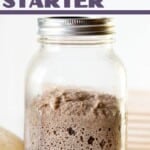
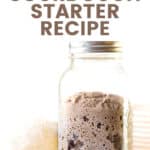
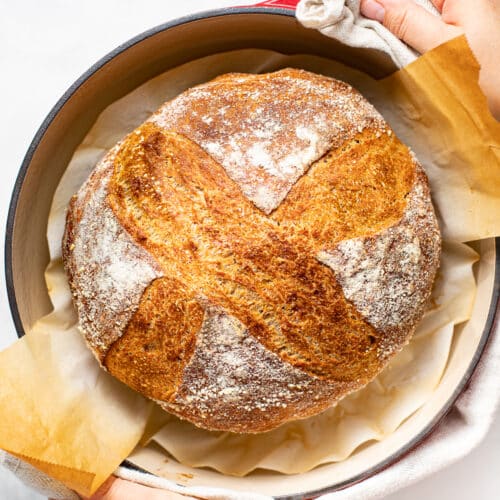
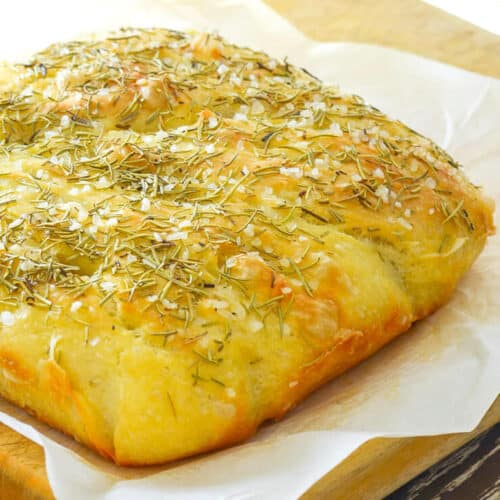

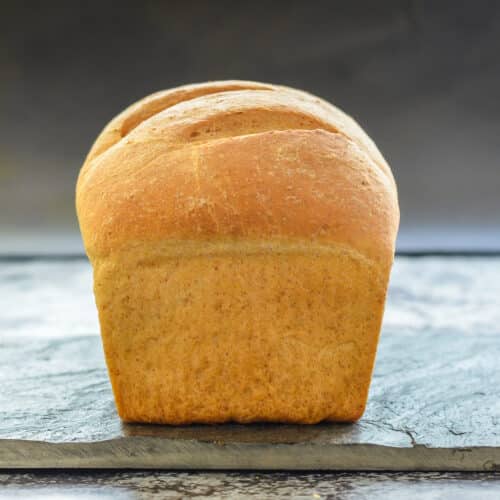
Char says
Hi! I just wanted to let you know how impressed I was with your post. You took the time to explain everything in a clear and easy to understand format. This makes sourdough so approachable! I'm a baker, but i don't usually mess around with sourdough because of the waste involved. Since coming across your post, i am so fired up and ready to give it a go! I will definitely be back to post my experience. Thank you for such an informative and helpful post!
Melanie McDonald says
I'm really pleased you've found it helpful. Have fun making your starter!
Char says
Hello again! so i'm almost at day 7 of my starter. i sstarted with whole wheat for the first 3 days and then switched to all purpose. On day 2 within a few hours of feeding it doubled up nicely. Then it went down. Fed it the next day, very little rise. ...and it continued like that...through each day. Ive also noticed a whitish film on the top. i almost think its mold but maybe not? i've been feeding it everyday, but i'm wondering if this is going to work for me. If its a fail or if i will need to keep going a bit longer. I've noticed various smells. From a pleasant yeasty one to the nail polish remover smell. Do you think im on the right track?
Melanie McDonald says
This recipe uses rye flour. My method (no discard) doesn't work as well with other flours and definitely not all-purpose. It doesn't contain enough nutrients and your bacteria will starve with the small feedings. If you want to use all-purpose flour I recommend using a starter method that is designed for it and you will need to feed more and discard.
Ginette Bisaillon says
Giving you five stars even though I'm only on my fourth day because it's looking good and I'm being very hopeful. I say this after throwing away a "small" rye starter from another site which grew mould on the fourth day. I had never seen this before! I think it's because it was too liquid. The author claimed that this was essential with rye flour. I have created at least 10 sourdough starters over the years and I'm always sad every time circumstances forced me to say goodbye! One thing I have found which is pretty consistent is that the second day I got this huge surge of bubbles and you think that's it but the next day nada. That's why I think I'm hopeful on the fourth day because that's when it should come alive in my estimation. I will keep you posted if that's OK.
Melanie McDonald says
So pleased it's working out for you so far!
Hannah says
I am a first time sourdough baker and I am confused on what to do post feeding the starter for 7-8 days. I cannot find any instructions on what is next; any help would be appreciated!
Melanie McDonald says
If it's ready then you can bake with it. If not then you need to continue feeding it until it's consistently rising and falling. The last 3 steps of the recipe explain what to do with it once ready, and the recipe notes explain how to bake with it. Hope that helps!
Poppy says
Thank you for instructions on the starter. I will try your no need sourdough. It mentions 100% starter hydration. Do I need t to do anything to the starter to get it to this point?
Many thanks
Melanie McDonald says
My sourdough starter recipe makes a 100% hydration starter. If you don't use a 100% hydration starter then you just need to adjust the amount of flour and water in the recipe to compensate.
Samantha says
Thanks so much for these instructions and your recipe.
I began my starter yesterday. I still have to feed it this morning, but am wondering is it's ok that it looks dry and chunky. I'm pretty sure if I turned the jar over and left it, what's in there now would still be clinging to the bottome. Will it thin over time?
Melanie McDonald says
It is a very thick starter and will cling to the jar. As long as you weighed the flour and water as per the instructions your ratios will be correct. There are pictures of what it should look like after every step in the post so you can compare how yours looks to mine. Hope that helps!
Sarah says
Good evening! I haven’t yet begun this process because I live in a rural area and am having trouble finding rye flour. We are wheat farmers and I would love to be able to use our fresh ground wheat (so please comment if that’s a 2nd best to rye). However, when I do finally get going, when is a good time in the process to share a portion, as a starter, with a friend?
Thank you!
Melanie McDonald says
You can certainly use wheat flour to make a starter but with this method rye is most successful. Other flours when made into a starter do not do so well with this no discard method and being left in the fridge unfed between bakes. For a first starter rye is by far the easiest and least temperamental to begin with.
Having said that, as you are a wheat farmer and your flour likely has more nutrients than most store-bought flours, you might find it works ok. There's only one way to find out!
In answer to your other question, for sharing I would wait until your starter is consistently doubling and very bubbly after feeding. Then one day when you feed it to make a loaf, just feed it a little more than you need and scoop the extra out into a new jar for your friend.
Hope that helps!
Sarah says
Great, thanks so much!
Sarah says
Sorry, I have another question! I’m on day 3, I am seeing activity which is great but it has a pretty foul smell. I’m worried it got too warm. My kitchen is pretty cool so I turned on my oven light and have kept the jar in the oven (with the light on) since the beginning. I put a thermometer in the oven, just out of curiosity, and it reached 100°. Is that too warm? Could that be the cause of the strong smell? Do I need to start again? Note, I am using the fresh ground wheat because that’s what I had available.
Also, the starter left on the sides of my jar after feeding and stirring have become pretty crusty and dry, making it difficult to keep a smooth starter. Could this also be from the too warm oven? Another reason to start over?
Thank you in advance for answering all these questions!
Melanie McDonald says
That is way too warm. As long as your kitchen isn't freezing cold it should be just fine on the counter. I live in Canada and never add extra heat to mine. It's either on the counter or in the fridge.
Your starter should never smell foul though. If it smells cheesy or really stinky then it's gone off. It should smell yeasty, vinegary or like nail polish remover. They are all unique so no two will smell the same but it definitely shouldn't be foul.
The sides of your jar will get a little dry and crusty but yours probably more so as it's been so hot and dry. To avoid too much dry crust, once I've stirred mine I use a spatula to push down all the clingy bits from the edges.
Hope that helps!
John says
Hi Mel
Thank you for your amazingly easy sourdough starter recipe. I’m only on day three and it’s already bubbling away nicely. I lost my original starter because my fridge went on the blink and as I live in the tropics I had to ditch it. That took me weeks to develop and I used the discard method and it definitely didn’t show much activity for ages. Can’t wait to use it and I will let you know how it goes - many thanks again, John xxx
Melanie McDonald says
You're welcome, John. I'm glad it's working well for you so far!
Wendy Winch says
I've been looking for an easy sourdough starter that doesn't discard . Came across yours and it was just what I was looking for. Started yours and I'm up to day 5 and it's been doubling in size since day 4 . Today I fed it and within a couple of hours it had already doubled in size. Should I keep going to day 7? How do I then proceed with this starter and do you remove the amount of starter required for making a loaf. Can I make one on the day or should I put in a clean jar the amount I need for the loaf and place in fridge. Do I need to feed it ? I'm a bit lost on this ?
Holly @ A Virtual Vegan says
Hi Wendy. As per the instructions for Day 4 in the recipe, "Don't get excited and think it's ready to use yet though. Sometimes this happens, then the activity will stop again for a few days, so keep going for now."
It is best to keep going for 7 days so you know for sure it is ready and strong enough to make bread.
Mel has covered all of the other questions you've asked in the post, recipe and recipe notes.
Best of luck with your bread baking!
Tay says
Hi Mel,
I'm brand new to sourdough, and I came across your recipe as I was searching for a way to make a starter with less waste. I'm currently trying your recipe and am on Day 5! It seems to be going well, though the smells are hard for me to decipher good vs bad, so that led me to do a little more research beyond your post. I found that the majority of recipes seem to stress the 1:1:1 minimum ratio of feeding until it is established, starter:flour:water, or maybe 1:2:2, which led me to wonder and want to understand how your recipe works when it is doing the opposite ratio-- starting at that 1:1, but then getting up to 12:1:1 by day 7. Could you explain what makes your recipe so different but still work? Because it seems to be working so far!! And I love the no-waste! Though I'm not sure why it is working and not starving, because on paper, I would think my starter would be pretty hungry in those later days with that high ratio of starter to food. (So I'm hoping the smells I'm smelling aren't due to mine being hungry...) Thanks in advance for helping me understand better!
Melanie McDonald says
I'm glad it seems to be working for you!
I am no scientist so have no idea why it works. All I know though is that it does work and the rye flour is definitely key. This method doesn't work nearly as well with any other type of flour. Probably because rye has a lot more nutrition for the bacteria and keeps them happy. They are way more temperamental with other flours.
I've been using this method to make and bake with starters for decades and except when I was first starting out and learning, I have never discarded. My first rye starter thrived on neglect and this recipe evolved from there.
I just can't get my head around how wasteful (and costly) discarding is. I mean I know you can technically cook/bake with the discard, but not many people want to be making and eating sourdough pancakes and banana bread every few days to use it all up.
It sounds like you're on the road to a happy, thriving starter. They all smell different and have different personalities. You'll get to know yours as it evolves! Best of luck!
A says
I have followed your recipe exactly. Using the rye, using the scale, using bottle water at room temperature, using a wooden and not metal spoon to stir. Its day 9 and it only goes up about 1cm. I had to throw some out yesterday to keep on feeding because it was getting too big. What can i do to make it work? Thanks a lot in advance! :)
A says
Me again, I will reply to myself. After posting this comment the starter went crazy and its more than doubling in size, now my problem is that i put in fridge the minute i have “fed” it and 12 hours later its nearly tripled in size. What do i do? I continue feeding it when it reaches that or do i let it sit and deflate and wait a week? (In the fridge the whole time)
Sandy says
I have a question about rye flour used for your sourdough starter recipe.
I found a reputable online mill where I can purchase fresh rye flour in 5 lb bags. They offer 3 kinds of whole rye flour (all organic):
1. Dark rye (10.9 protien),
2. Medium white rye (type 110)
3. Pumpernickel rye (milled course).
Is one type better than the other for the starter or perhaps one that might be difficult for someone who has never done a starter before?
Melanie McDonald says
I use dark rye flour and think that will be best. Don't get the white rye because it will have been refined so won't have as much "food" for the bacteria to eat which will make your starter harder to get going. I've never seen pumpernickel rye here but from a quick Google search it looks like it's usually quite a coarse flour. It would probably be ok but I've never tried it. Stick with the dark rye. Hope that helps!
Kumar says
Hey Mel,
A pleasure to visit your blog pages. I love Sourdough and I love wholemeal. I was using yeast to ferment my sourdough bread and now I prefer using natural wild yeast.
Here is what I did:
Day 1: 15 grams of wholemeal (sifted) flour + 15 grams of water
Day 2: While adding mater I accidentally added 33 grams so I add 33 grams of the same flour and mixed it. I live in Auckland, New Zealand and despite being summer and hot the temperature is not consistent day in day out. Instead, I leave it in the oven with the light on and it is constant 28.5C/83F and then I turn off the light in the night and it drops back to about 24.5c/76F. I mixed this at 8 AM and put it in the oven and the size quadrupled by 1 PM.
Would you add more flour and water to it since it is quadrupled or will you leave it for today and continue the process on Day 3?
Kumar
Melanie McDonald says
As it's being kept so warm, and because you aren't using rye flour, you will probably find that this recipe doesn't work well for you. For it to work well, rye flour is required as per the recipe. Wholewheat flour doesn't contain as many nutrients for the bacteria to eat (and sifted wholewheat even less) so they will be hungry more quickly which is why it doesn't tend to work as well. That coupled with the very warm temps your starter is kept, isn't a good combination because the temperature will speed everything up and they will run out of food even more quickly. If you can switch to rye flour you will have a much better chance of it being successful. If you can't, you would probably be better off using a more traditional starter recipe which involves discard. If you have to feed it more than once a day a no discard method won't work for you because you'll end up with an unmanageable amount of starter without discarding. I hope that helps!
Humi says
Hi Mel. I followed your recipe and on day 5 I developed a layer on my starter, almost like a dry layer but it has white filaments (spidery lines) on this layer. Despite this my starter rose and fell. I mixed it in and fed it for Day 6 and it rose double. Is it still safe to use?
Rosalind says
I have been struggling to get my sour dough starter going now for for more than 2 months
I started with 15 grams of Rye flour and 15 grams of lukewarm water. Feeding everyday with the same ratio.
Placed both bottles on top of my fire place which is warm (BTW I am in BC Canada).
Only a teeny weeny bubbles so far. After reading some blogs I followed the advice to activate it adding
warm apple juice and same ratio of water rye flour for 2 days. It flourished and rose twice the volume. It was active and fluffy.I was happy thinking it is going to happen after all.
I reverted to warm water and rye flour routine and it fell back to as sluggish as before. Since it has continued for weeks without results I started discarding the top layer everyday .
I feed it same ratio, stir at least twice a day to aerate it. Each morning there is a crust on top of somewhat
thick and gummy dough with tiny speck of small bubbles.
What am I doing wrong?
I keep reading that Patience is Key but I cannot figure why my starter is going nowhere. I would appreciate very much
you guidance and help.
Thank you
Rosalind.
Melanie McDonald says
There are many different methods for making a starter and they will all work given time and the right conditions, but it's really important to choose one method and stick to it rather than chop and change. Starters need routine and switching up what you're doing will just confuse your bacteria and you won't get consistent results. If you want to make a waste-free no discard starter then follow my method and if you don't mind discarding, find a more traditional discard method that you like. Just be consistent.
With regards the crust, have you got a loosely fitted lid on it as per my instructions? If it doesn't a crust will develop. Keep a lid on and it should stay moist and crust-free.
Also my recipe states to use 25 grams of flour and 25 grams of water, not 15. The volume using 25 grams of each is already very small. If you're using half that, that could be another reason it's drying out and getting a crust.
If you're in BC, it's not really very cold even in winter, and at the moment it's still pretty mild. Your starter doesn't need to be on the fire place. It will be fine on the kitchen counter. If you are putting your fire on (even if you've only had it on once) I can pretty much guarantee your starter is getting too hot above it. Heat rises. When the bacteria get too hot they die. Just keep it in the kitchen. Mine lives there all year here in Victoria and does just fine.
You should not be stirring it twice a day. My instructions don't say to do that. You just stir it when you add the flour and water. I also don't say to use warm water. It should be room temperature.
My biggest tip is not to overthink it. Feed it water and good quality rye flour once a day at roughly the same time as per my instructions and forget about it the rest of the time. If you miss a day don't worry and just feed it when you remember or the next day.
I hope that helps!
Rosalind says
Per your advice and instructions, I have since scooped a large tablespoon each into 2 clean mason jars and fed 25gm room temp water 25 gm rye flour covered loosely. Jars now on kitchen countertop .Shall be watching it and will give you a report in 7? days. Keeping my fingers crossed. Thank you for your help.
Jackie says
I have started a rye starter with another recipe and suggestions, directions. And I too wondered, why am I throwing all this out. When shall I get enough to make a loaf of bread? After searching for other recipes , I found this recipe! And I am most excited! I did not want to throw this out as the other recipe required. I am happy to say at day 4 my starter looks as it should on my counter. I shall continue as your recipe requires for day 5 etc and hopefully I will be able to make bread this week. Thanks for your work!
Melanie McDonald says
I'm so pleased you found it. Discarding is so wasteful. I hope your new starter makes you great bread!
Mei says
Thanks for the detailed recipe Melanie! By far the easiest to follow and the least wastage.
My starter was ready on Day 11. I have since baked a few loaves successfully!. Am so thrilled and can't wait to try more recipes
Chloe Meyer says
I am on day 4, but on day 2 & 3 I had a lot of hooch(I had to look up what it was called) on top of mine. Is this normal?
Melanie McDonald says
That early in the process I'd ignore it and just stir it in. If it keeps happening as it matures though your starter is likely hungry. I'd look at the flour you are using. Be sure it is a good quality, natural rye flour with no additives. For it to be successful your bacteria need good nutrition or they won't thrive.
Chloe Meyer says
Thank you!!
Manasa says
Hello! I don't eat commercial bread and recently found out that spelt sourdough was good for those with sensitive stomachs so I decided that I would give it a try. While I am otherwise a confident cook and baker, sourdough is a whole new thing for me! I started searching how to make a starter, read through a few articles, and came across this one! Wow, thank you so much for the easy to follow instructions and easy to understand information. I have read through it now several times and feel comfortable-- and excited-- to do this! I plan to get a kitchen scale and new jar and start tomorrow! Thanks again! I'll come back here in a couple of weeks and give an update about my first loaf. :)
Adele says
This is the most helpful, information packed blog I have ever read about making a sourdough starter, I feel motivated and confident not, tomorrow morning I will begin my starter, wish me luck! :D
Melanie McDonald says
That's so great Adele. Have fun and enjoy the process!
Liz says
Hi Melanie, thank you for this recipe - it makes so much more sense than many others! One question - when you say the starter will double, does it do in both cases if say you're only adding 25g flour + 25g water to say 350g of starter and likewise using 75g flour+75g water to 25g of starter? Also can you use the starter in your bread before it peaks/doubles to avoid the risk of using it too 'late' after it's fallen? Thank you!